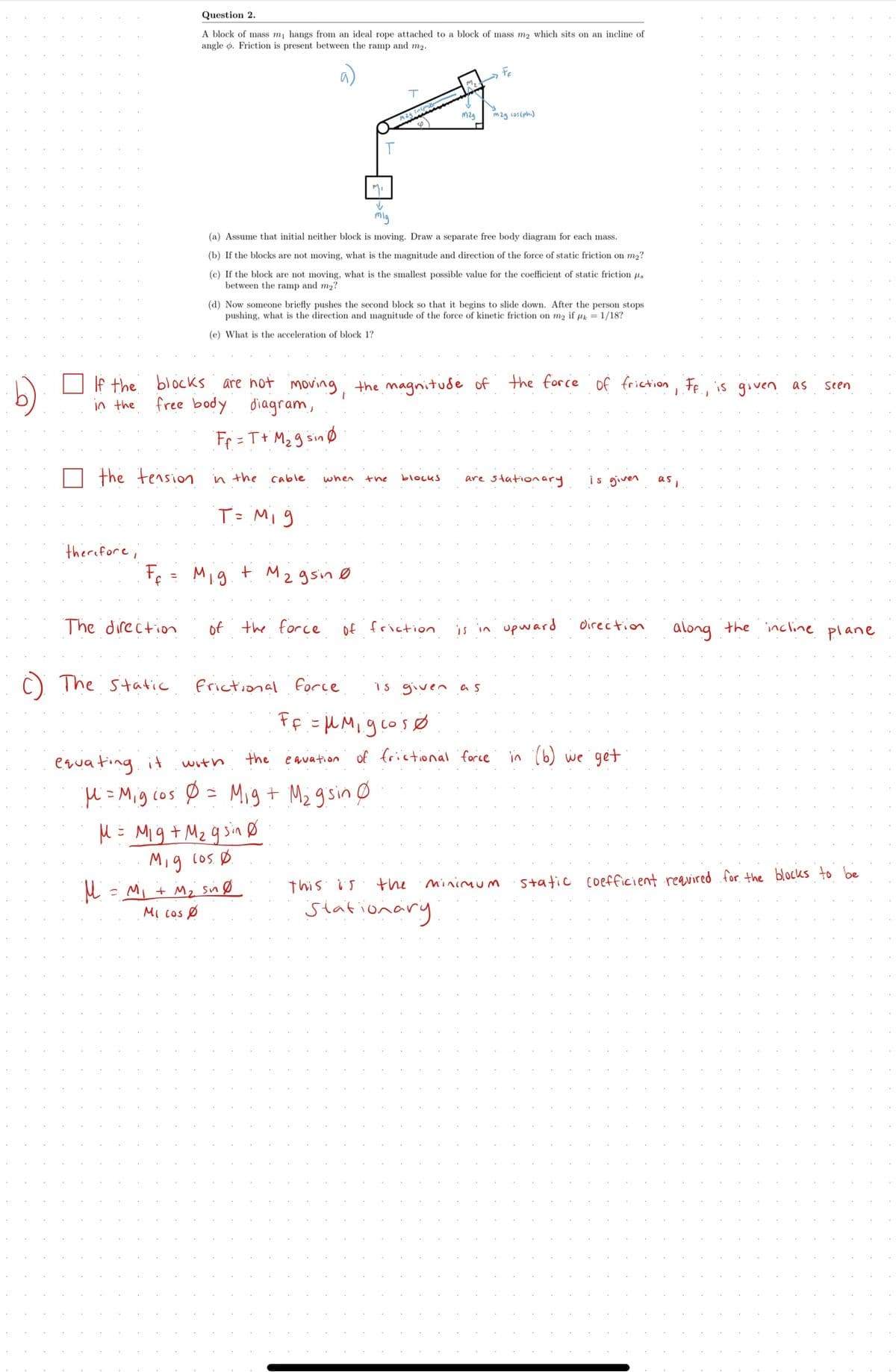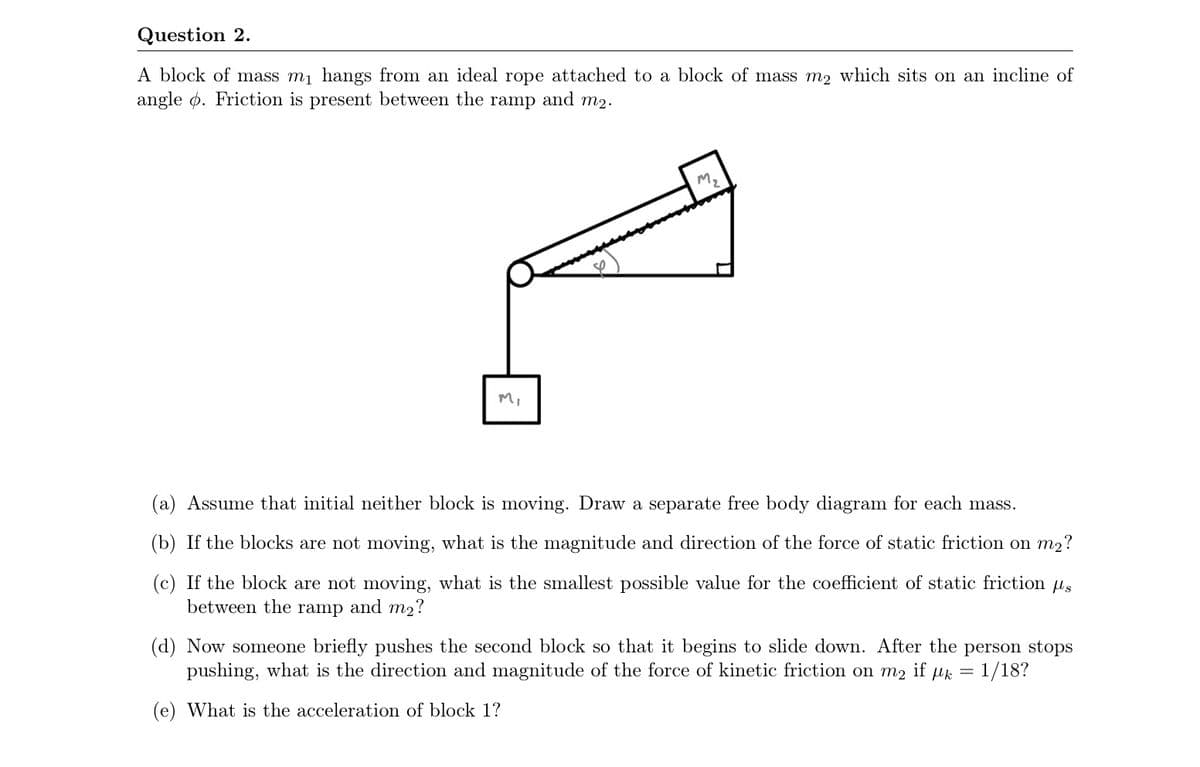(d) Now someone briefly pushes the second block so that it begins to slide down. After the person stops pushing, what is the direction and magnitude of the force of kinetic friction on m2 if uk = 1/18? (e) What is the acceleration of block 1?
(d) Now someone briefly pushes the second block so that it begins to slide down. After the person stops pushing, what is the direction and magnitude of the force of kinetic friction on m2 if uk = 1/18? (e) What is the acceleration of block 1?
Principles of Physics: A Calculus-Based Text
5th Edition
ISBN:9781133104261
Author:Raymond A. Serway, John W. Jewett
Publisher:Raymond A. Serway, John W. Jewett
Chapter4: The Laws Of Motion
Section: Chapter Questions
Problem 8P: A 3.00-kg object is moving in a plane, with its x and y coordinates given by x = 5t2 1 and y = 3t3...
Related questions
Question
Please answer question 2, parts d and e

Transcribed Image Text:Question 2.
A block of mass m, hangs from an ideal rope attached to a block of mass m2 which sits on an incline of
angle ø. Friction is present between the ramp and m2.
M2g
m2g coslphi)
mlg
(a) Assume that initial neither block is moving. Draw a separate free body diagram for each mass.
(b) If the blocks are not moving, what is the magnitude and direction of the force of static friction on m2?
(c) If the block are not moving, what is the smallest possible value for the coefficient of static friction u.
between the ramp and m2?
(d) Now someone briefly pushes the second block so that it begins to slide down. After the person stops
pushing, what is the direction and magnitude of the force of kinetic friction on m2 if µk = 1/18?
(e) What is the acceleration of block 1?
the force of frietion, Fe, is given as
If the blocks are not moving, the magnitude of
diagram,
seen
in the
free body
Ff = T+ Mgg sinØ
the tension
in the cable
are stationary
is given
when
the
blocus
as
T= M, 9
therefore,
Fe = Mig. + M2gsin Ø
The direction
of
the force
of frictio
is in upward
direċtion
along the incline
plane
C) The static
frictional force
1s given as
Ff =HM, gcosø
of frictional force
in (6) we get
erva ting it
je = Mig cos Ø = Mig+ Mz g sin Ø
M= Mig+ Mz g sin Ø
the
equation
with
こ
Mig cos Ø
Minimu m
Static coefficient reavired for the blocks to be
the
+ M, snØ
MI cos Ø
this is
stationary

Transcribed Image Text:Question 2.
A block of mass m1 hangs from an ideal rope attached to a block of mass m2 which sits on an incline of
angle ø. Friction is present between the ramp and m2.
M.
Mi
(a) Assume that initial neither block is moving. Draw a separate free body diagram for each mass.
(b) If the blocks are not moving, what is the magnitude and direction of the force of static friction on m2?
(c) If the block are not moving, what is the smallest possible value for the coefficient of static friction us
between the ramp and m2?
(d) Now someone briefly pushes the second block so that it begins to slide down. After the person stops
1/18?
pushing, what is the direction and magnitude of the force of kinetic friction on m2 if µk =
(e) What is the acceleration of block 1?
Expert Solution
Step 1
a)
Analyze the following figure.

Applying Newton’s law in the direction perpendicular to the inclined plane.

Here, N, m2, ay, and ϕ represent the normal force, the block’s mass, the block’s acceleration, and the inclined plane’s angle, respectively.
The block’s acceleration in the inclined plane’s perpendicular direction is zero.
Thus,

Now, the kinetic friction force can be determined as,

Here, μk represents the coefficient of kinetic friction.
Substitute the relevant values.

Trending now
This is a popular solution!
Step by step
Solved in 2 steps with 10 images

Knowledge Booster
Learn more about
Need a deep-dive on the concept behind this application? Look no further. Learn more about this topic, physics and related others by exploring similar questions and additional content below.Recommended textbooks for you

Principles of Physics: A Calculus-Based Text
Physics
ISBN:
9781133104261
Author:
Raymond A. Serway, John W. Jewett
Publisher:
Cengage Learning

Principles of Physics: A Calculus-Based Text
Physics
ISBN:
9781133104261
Author:
Raymond A. Serway, John W. Jewett
Publisher:
Cengage Learning